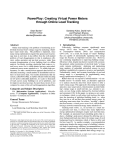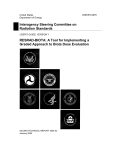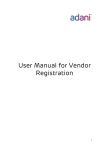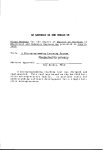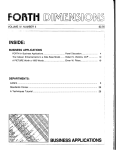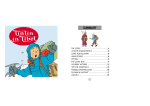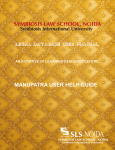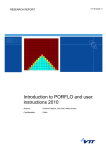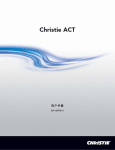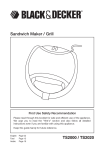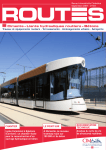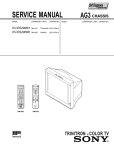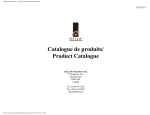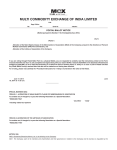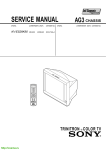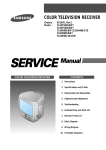Download IRC SP 038: Manual for Road Investment Decision Model
Transcript
Indian Roads Congress Special Publication 38 MANUAL FOR ROAD INVESTMENT DECISION NEW DELHI 1992 MODEL Digitized by the Internet Archive in 2014 https://archive.org/details/govlawircy1992sp38_0 ) : Indian Roads Congress Special Publication 38 MANUAL FOR ROAD INVESTMENT DECISION MODEL Published by The Indian Roads Congress Copies can be had from The Secretary, Indian Roads Congress, Jamnagar House, Shahjahan Road, New Delhi-1 10011 NEW DELHI 1992 ^S^fcstage (Plus packing & postage charges) Published in February, 1992 Reprinted August, 2005 : (The Rights of Publication and Translation are reserved) Printed at Sagar Printers & Publishers, New Delhi (500 copies) MEMBERS OF THE HIGHWAYS SPECIFICATIONS AND STANDARDS COMMITTEE 1. R.P.Sikka (Convenor) 2. P.K. Dutta Chief Engineer (Roads), (Member-Secretary) Ministry of Surface Transport (Roads Wing) 3. S.S.K. Bhagat Addl. Director General (Roads), Ministry of Surface Transport (Roads Wing) Chief Engineer (Civil) New Delhi Municipal Committee Rama Chandran 4. P. 5. Dr. S. 6. A.N. Chaudhuri Raghava Chari Chief Engineer (R&B), Govt, of Kerala Head, Transportation Engineering, Regional Engineering College, Warangal Chief Engineer (Retd.) Assam Public Works Department 7. Dr. M.P. Dhir Director (Engg. Coordination), Council of Scientific 8. N.B. Desai & Industrial Research Director, Gujarat Engineering Research Institute 9. Dugad J.K. Chief Engineer (Mechanical), Ministry of Surface Transport (Roads Wing) 10. Lt. 11. Dr. Gen. M.S. Gosain A.K.Gupta Director General Border Roads Professor & Co-ordinator, University of Roorkee 12. D.K. Gupta 13. D.P. Gupta Chief Engineer (HQ) UP PWD Chief Engineer (Planning), Ministry of Surface Transport (Roads Wing) Das Gupta 14. S.S. 15. Dr. L.R. Kadiyali 16. Dr. LK.Kamboj Senior Bitumen Manager, Indian Oil Corporation Ltd., Bombay 259, Mandakini Enclave, New Delhi Scientist-SD, Ministry of Environment & Forest 17. V.P. Kamdar Secretary to the Govt, of Gujarat Roads 18. M.K.Khan 19. Ninan Koshi & Buildings Department Engineer-in-Chief (B&R), Andhra Pradesh Addl. Director General (Bridges), Ministry of Surface Transport (Roads Wing) 20. P.K. Lauria Chairman -cum -Managing Director, Rajasthan State Bridge Constn. Corpn. Ltd. 21. S.P. Majumdar Director, R&B Research Institute, West Bengal 22. N.V.Merani Principal Secretary to the Govt, of Maharashtra, PWD CRRI 23. T.K. Natarajan Director (Retd.), 24. G.S. Palnitkar Engineer-in-Chief, 25. M.M. Patnaik MP PWD Engineer-in-Chief-cum-Secretary to the Govt of Orissa 26 Y.R. Phull Deputy Director CRRI 27. G.P. Ralegaonkar Director & Chief Engineer, Maharashtra Engineering Research , Institute 28. G. Raman Director (Civil Engineering), Bureau of Indian Standards 29. A. Sankaran Block No. 1/7/2, 51, Shangirla, G.O.C.H. Colony, 22nd Cross, Besant Nagar, Madras 30. Dr. A.C. Sarna General Manager (T&T), 31. 32. R.K. Saxena N.Sen RITES Chief Engineer (Roads), Ministry of Surface Transport, (Roads Wing) Chief Engineer (Retd.), 12-A, New Delhi Chitranjan Park, General Manager (Technical), Indian Road Construction Corporation Ltd. 33. M.N. Singh 34. Prof. 35. M.M. Swaroop C.G.Swaminathan "Badri",50, Thiruvenkadam Street, R.A. Puram, Madras Secretary to the Govt, of Rajasthan, 36. The Chief Engineer PWD Concrete Association of India, Bombay 37. The Chief Project Manager (Roads) Rail India Technical & Economic Services Ltd. 38. The Director Highways Research 39. The Engineer-in-Chief Haryana P.W.D., 40. The President Indian Roads Congress (V.P.Kamdar), Station, Madras B&R Secretary to the Govt, of Gujarat (Ex-officio) 41 . The Director General (Road Development)& Addl. Secretary to the Govt, of India (K.K. Sarin) (Ex-officio) 42. The Secretary Indian Roads Congress (D.P.Gupta) (Ex-officio) Corresponding Members 43. M.B. Jayawant Synthetic Asphalts, 103, Pooja Mahul Road, Chambur, Bombay 44. O. Mutahchen Tolicode 45. A.T. Patel Chairman & Managing Director, Appollo Earth Movers Pvt.Ltd., , P.O. Punalur, Kerala Ahmedabad FOREWORD Highway improvement programmes are assuming increasing importance in view of the fast growing road transport needs of the country. However, as it is essential that the projects should be economically context, economic evaluation has become a handy tool for resources are scarce justifiable. In this making correct investment decisions. Indian Roads Congress had published in 1984 a Manual on Economic Evaluation of Highway Projects in India. This enabled the highway engineers to carry out economic analysis of road improvement projects in a scientific manner. The analysis of different options with this procedure by manual calculations is however, a time consuming task, due to which the technique has not been used to its full advantage. The computer model now developed overcomes and enables quick detailed analysis of various alternatives. this difficulty The Manual for Road Investment Decision Model is the first Computer based manual published by the Indian Roads Congress. A programmed floppy which is enclosed with this manual will help the user to make use of computer for economic analysis. The model is very easy to use and caters to the requirements for analysing alternative proposals, evaluating alternate strategies and ranking schemes in order of priority. The Manual fulfills a long felt need and its widespread use by highway engineers will have a beneficial effect on planning and preparation of highway projects in India. CONTENTS Page RIDM 1. The 2. Programme Installation 3. Input Data Requirements 4. Procedure 5. 6. ... 1 ... 11 ... 13 ... 17 Sample Run ... 20 References ... 24 ... 5 ... 6 ... 13 ... 16 ... 8 ... 9 And Output Reports To Run The Programme TABLES Table 1. Speed Row Equations Table 2. Recommended Design Table 3. Major Inputs to Service Volumes RIDM Table 4, Output Reports Generated by RIDM FIGURES Fig-1 Structure of Fig-2 Flow RIDM chart for calculating VOC APPENDICES Appendix 1: Fuel Consumption Equations ... 25 Appendix 2: Input Format with Specimen Data ... 26 Appendix 3: Economic Analysis without Tim'e Savings ... 29 ... 30 Appendix 4: Economic Analysis with Time Savings Contd. Appendix 5: Net Present Value Appendix 6: Roughness Appendix 7: v/s v/s Discount rate- Graph Year- Graph Vehicle Operating Cost v/s Year- Graph .... 31 .... 31 ... 32 1. 1.1. THE RIDM Introduction The Road Investment Decision Model (RIDM Version- 1 ) is a to carry out economic evaluation of highway projects in accordance with the procedure described in the IRC Special Publication-30 "Manual on Economic Evaluation of Highway Projects in India" with modifications as described in para 1.2. Economic analysis involves quantification 1.1.1. computer based model designed total transportation cost components for alternative strategies for road improvement and evaluating each of them against the "do nothing" alternative. Proper analysis of various options by manual calculations is a time consuming task, which makes it difficult to use the technique to full advantage manually. The computer model overcomes this shortcoming and enables detailed analysis of possible combinations of alternatives quickly. The Model has been developed using Lotus 1-2-3 Software and its advanced macro programming features. It has been tested and applied on a number of major national highway projects pertaining of the to widening, strengthening, construction of bypasses etc. 1.1.2. This publication is a user Manual for RIDM and describes the procedure for running the model based on the floppy disk which is enclosed with the Manual. 1.1.3. The Computerisation Committee of the Indian Roads Congress (personnel given below) in their meeting held at New Delhi, on the 6th February 1990, discussed the Package on Economic Analysis developed by the Ministry of and set up a working group comprising Dr. L.R. Mathur and M.K. Saxena to finalise the same. The draft as finalised by the Group, was placed before the Highways Specifications & Standards Committee in their meeting held on the 30th October, 1990. In light of the comments offered by the Members of Highways Specifications & Standards Committee during the meeting, the draft was further modified by S/Shri S.C.Sharma, M.K.Bhalla and J.B. Mathur. Surface Transport Kadiyali, S/Shri J.B. Convenor Member-Secretary K.K.Sarin M.K. Saxena Members Dr. B.P. Bagish Prof. C.S. P.L. Bongirwar Dr. S.S. Chakraborty Dr.V. Thiruvengadam Rep. of National Informatics Centre (N.Tirkey) Rep. of Gammon India Ltd. (S.V. Chaukulkar). Rep. of Tata Consulting Services Dr. M.P.Dhir Dr. S.S. Jain Dr.L.R. Kadiyali Dr.B.R. Marwah J.B. Mathur Surana M.G. Tamhankar 1 1 .4. The modified draft was subsequently considered and approved by the Executive Committee in their meeting held on the 18th November, 1990. Thereafter, the draft was taken up for discussion by the Council in their meeting held on the 8th December, 1990. The Council authorised the Convenor of Highways Specifications & Standards Committee to do the necessary modifications based on comments received. Accordingly the draft was finally modified by the Convenor, Highways Specifications and Standards Committee for printing as one of the IRC Publications . Modifications in IRC:SP:30-1984 'Manual on Economic Evaluation of Highway Projects in India' 1.2. The following modifications have been incorporated (i) in the model: The IRC Special Publication-30 specifies the design service volumes for various pavement widths in terms of vehicles per day, whereas this Model considers the design service volumes in terms of Passenger Car Units (PCU) per day, in line with the revised IRC standard IRC:64-1990 'Guidelines on Capacity of Roads in Rural Areas' (First Revision) (ii) relationships given in Table 2 of IRC:SP:30-1984, which speed and the hourly volume in terms of number of vehicles, have not been used in the model as new Speed- flow equations have become available through a recent research study (Ref.4). The new Speed-flow equations, which relate the speed and traffic volume in terms of PCU/hr. have been incorporated in the model. The equations are given in Table 1. The Speed -volume relate the Capabilities 1 .3. and Applications of the Model The RIDM carries out economic evaluation of highway schemes at project level for road investment decision making. Its major capabilities and applications are:(i) 2 The model is very easy to use and adequately caters to the requirements of highway organisations for analysing alternative proposals to select the best option from a number of alternatives at project level. It is fully interactive for specifying input data and retrieval of results in proper report forms. The model takes 4 to 5 minutes to load the programme, retrieve input data a pair of alternatives and generate output reports. (ii) file and analyse The model can evaluate alternative strategies such as stage construction or full construction alternative specifications for carriageway width, pavement structure etc. can be used to rank schemes (iii) It (iv) The model can in order of priority. also analyse the sensitivity of the result to changes in unit prices of resources, traffic growth rate and design parameters. (v) With a Model can slight modification in the programme, the generate vehicle operating cost tables. Basic Relationships Incorporated into the 1 .4. The model considers 1.4.1. which constitute the Model the following three cost components total transportation cost: (i) Construction cost (ii) Maintenance cost (iii) also be used to Road user cost The road user cost time cost and accident cost. 1.4.2. The is composed of vehicle operating cost (VOC), travel construction cost and maintenance cost are specified by the user directly whereas the vehicle operating cost and travel time cost are calculated by the model endogeneously using the VOC equations and Speed-flow relationships. 1.4.3. The construction cost and maintenance cost of the facility are specified by the user in financial terms. economic costs using the following The financial costs are converted into relationship: ECONOMIC COST = ECF * FINANCIAL COST where: ECF = Economic cost conversion factor. A default value of 0.8 different value for 1 .4.4. has been adopted for ECF. The user can specify a ECF while feeding input data. Vehicle Operating Cost : The vehicle operating cost relationRoad User Cost Study ship for cars, buses, and trucks formulated on the basis of the and used for preparing VOC Tables in IRC:SP:30- 1984, have been built into the model. The fuel consumption equations have been slightly modified to consider 3 instead the effect of road profile in terms of combined rise and fall (absolute values) equations consumption fuel modified The separately. fall of specifying rise and incorporated in the model are given in Appendix-1. The modification does not introduce any variation in fuel consumption values. A fixed value of 0.02 Rs/Km in all conditions. (at 1984 prices) is taken as lubricant cost for operation of a car The model using the VOC equations predicts physical quantities of the consumed by cars, buses & trucks. These quntities are then multiplied by the unit prices of the consumables as specified by the user to give VOC. For two wheelers VOC is taken as 20 per cent of VOC of cars. resources 1 .4.5. Congestion effect : When traffic volume exceeds the design service volume (para 1.4.3.), the vehicles are subjected to congestion effect as compared to steady state conditions. To account for this resulting in higher VOC the following congestion factors are used in the model: VEHICLE FACTOR Cars 1-64 Buses 1.28 Trucks 1.31 In case of congestion the calculated values of the components for fuel, and maintenance labour are increased by multiplying tyre, lubricants, spare parts these values with the above factors. 1 .4.6. Speed volume relationships The Model : calculates speeds of the vehicles for quantifying travel time savings using speed-flow equations for cars, buses, trucks and two-wheelers for operation on single lane, intermediate lane, two-lane, and four-lane wide paved roads in plain, rolling and hilly terrain. The speed-flow equations are given in Table 1. If the calculated speed for any category of vehicle is less than 10 km/hr, a minimum cutoff value of 10 km/hr is assigned for determining the travel time savings. 4 Table Road Type Speed- Plain terrain Vc Vt Single lane Vb Vtw Intermediate lane Two lane =49.98 -0.041Q =42.45 - 0.024Q =46.92 - 0.032Q =42.98 - 0.035Q Flow Equations Rolling terrain Vc Vt Vb Vtw =47.48 =40.33 =43.63 =40*83 - - Hilly terrain 0.039Q 0.023Q 0.030Q o!o33Q Vc =41.48 - 0.034Q =32.69 -0.018Q Vb =35.66 - 0.024Q Vtw =36^96 - 0!030Q Vt Vc =64.04 - 0.020Q =51.05 - 0.010Q oc _CO VD -JO.OJ Vtw =53,10 -0.017Q Vc =60.84 -0.019Q =48.50 -0.010Q VD -jj.jZ - \J.\J\0\J Vtw =55.97 -0.017Q Vc Vt Vt Vt Vc Vc Vc =53.79 -0.017Q =39.82 - 0.008Q — A< — <+J.J i VD Vtw =49.49 -0.016Q =67.96 -0.012Q =58.96 - 0.008Q Vb =66.79 -0.013Q Vtw =51.58 - 0.007Q =65.24 -0.011Q =56.01 - 0.008Q Vb =62.78 -0.012Q Vtw =49.52 - 0.007Q =57.77 -0.010Q =46.58 - 0.006Q Vb =52.76 -0.010Q Vtw =40.75 - 0.006Q Vc Vc Vc - Vt - Vt Four lane Vt (Divided carriageway) Vb where 1. Vtw =68.73 - 0.0049Q =63.25 - 0.0047Q =74.48 -0.0042Q =57.21 -0.0062Q Vt Vt Vb Vtw =65.98 =60.09 =70.01 =54.92 - 0.0049Q 0.0045Q 0.0039Q 0.0059Q Vt =58.42 =49.97 Vb =58.84 Vtw =48.63 - - 0.0042Q 0.0037Q 0.0033Q 0.0053Q : = = = = = Q Vc Vt Vb Vtw volume of traffic in PCU/hour = 0. 10 PCU/day speed of cars in km/hour speed of trucks in km/hour speed of buses in km/hour speed of two wheelers in km/hour Accident cost: Accident costs are not calculated endogeneous1 .4.7. can be specified directly by the user by combining them with other cost parameters if required. ly but Design service volume: The design service volumes for the 1) and the proposed facility (ALT 2) are to be defined by the user as input parameters. The design service volumes for both the alternatives are to be chosen carefully duly taking into account various factors such as pavement 1.4.8. existing road (ALT width, shoulder width, type of terrain, curvature etc. To assist the user to select the design service volume a built in help facility has been provided in the model. The help facility displays the recommended design service volumes as per the IRC 'Guidelines for Capacity of Roads in Rural Areas' Table 2. The help facility can be invoked by pressing the following keys in the given sequence: Press 'Home' key Press 'Enter' key andH' keys together To revert to data input format press Press 'Alt 'Alt and V keys together. 5 : Table 2. Recommended Design Service Volumes (DSV) In PCU/DAY Rolling high ** Plain Terrain high ** low * Curvature Hilly Low low * high ** * Width 2000 6000 15000 35000 Single Lane Lane Two Lane Four Lane Inter. * 1900 5800 12500 1800 5700 11000 25000 low curvaiure (degrees per km) **high curvature (degrees per km) Terrain (Rise + Fall metre per km) 1700 5600 10000 1400 4500 5000 1600 5200 7000 16000 Plain Rolling Hilly <=50 >50 0- 15 <=100 >100 <=200 >200 30 30-50 1 5 - Notes Single -Lane (1 ) Roads Above values are applicable for paved carriageways with good quality shoulder minimum 1 m width on either side. When the pavement is not black topped of the (2) DSV may be lowered by 20 to 30 per cent In case of low quality shoulders (earthen shoulders of plastic soil) DSV should be taken as 50 per cent of the value given above. Two-Lane Roads m width on either side, (1) In case of paved and surfaced shoulders of at least 1.5 the DSV can be increased by 15 per cent. (2) Li case of restricted lane width or restricted shoulder width apply the following capacity reduction factors to the values given in Table 2. Capacity Reduction Factors Suggested for Substandard Lane and Shoulder Width on Tvvo-!ane Roads Usable Shoulder* width => 1.8 =>1.2 = >0.6 => 0.0 3.50 lane 1.00 0.92 0.81 0.70 m 3.25 lane m 0.92 0.85 0.75 0.64 3.00 m lane 0.84 0.77 0.68 0.58 Usable shoulder width refers to well maintained earth/moorum/gravel shoulder which can safely permit occasional passage of vehicles 6 ) Four-Lane Divided Roads (1) The values (2) In case well designed paved shoulders of 1.5 metre width are provided the DSV of four-lane dual carriageway road can be taken upto 40000 PCUs in plain terrain relate to 4-lane divided carriageway roads with no control of access. Traffic projections: These 1.4.9. are made using the following equation: PT = LT(l+r/100) LT = number of vehicles PT = number of vehicles where: r = annual growth in year n in year n+1 rate in per cent For converting the different types of vehicles to 'passenger car unit' the following equivalency factors are used: Car = 1 .4. 10. 1 , Bus = 3 , Truck = 3 , Two wheeler = 0.5 Unit cost of resources : (1) Unit price of consumables: The default values of unit prices of consumables (1984 price level) are taken from IRC:SP~30-1984 (2) Passenger time value and time value of commodity For converting time in monetary terms, the default values for passenger time value and time value of commodity in transit are based on 1984 prices as per IRC:SP-30.-1984 : The values adopted for occupancy of cars, two-wheelers and buses Average occupancy of a car 4.8 Average occupancy of a two-wheeler 1 .5 Average occupancy of a bus 43 (3) 1 .4. 1 1 . are: Updating of prices :The rates adopted as default values in respect of (1) and (2) above are given in Appendix 2. These values are required to be updated to current prices. This can be done either by (i) specifying current prices of each resource, or (ii) if current prices of consumables are not known, the 1984 values can be updated by specifying cost update factors for VOC and time values of passenger and commodity. Pavement roughness: The model calculates pavement rough- ness year wise as follows: PRG Year = End of construction Year = IRG = LRG+DRG (Intermediate years with no REN/STG) RRG (If Year = Year of REN/STG) where: IRG=Initial Roughness in (If mm/km at the end of construction (user specified) PRG=Present Roughness in mm/km LRG=Last year's Roughness in mm/km RRG=Roughness after Renewal/Strengthening in mm/km (user specified) DRG=Rate of increase of Roughness in mm/km per year (user specified) 7 Structure of the Model 1.5. RIDM is structured in three parts (i) Input (ii) Modelling & Simula- The tion and (iii) Results. The data input module is arranged in cells A1..G100. This is run the analysis programme. The module is fully interactive and presents a formatted screen giving a list of variables for which values are to be specified by the user to describe road characteristics, terrain, traffic volume, construction and maintenance costs, etc. for the alternatives to be evaluated. The variables and their limits are described in Section 3. 1.5.1. designed to create the input data The second 1.5.2. (Figs. 1 & 2) is stored in a file part of the file contains all OUTPUT roughness Deterioration rate, Road Roughness Deterioration (para 1.4.1 1) after Strengthening Traffic in base year traffic model which forms the core module named 'ECOCAL.WKT. This MODEL INPUT Initial file to growth Year wise roughness Year wise Traffic projection (para 1.4.9) rate terms of, traffic in cars, buses, trucks, ADT, PCU Year wise economic Phasing of Construction cost, Maintenance Cost, Cost of strengthening Project cost cost (para 1.4.3) (Financial Costs) Economic cost conversion factor Road width, RF, RG, Vehicle operating cost (para 1.4.4& Fig.2) Traffic design service volume, Resources Update factors Road width, cost, Terrain, (RF) Relationship wheelers for time saving (para 1.4.6) VOC VOC savings & time saving and Speed by vehicle type, Traffic, Economic Calculation and cost of construction and maintenance Length, Value of travel time for passenger commodity, discount rates VOC by vehicle type Speed of cars, buses, trucks and two Speed flow Traffic Year wise including the effect of congestion if any for cars, buses, trucks results & total cost, net benefits discounted (para 1.5.3) & benefits, NPV, IRR Graphs for NPV Discount rates RG, VOC(Car), year NPV v/s Graphics" VOC Fig. 1. Structure of 8 Discount rate year v/s (Car) v/s year Roughness RIDM Road width, RF Design service vol. Year of completion^ Design period Year=l =N Read for Year Roughness PCU/day Yes Year <= N. No Compute for cars buses, trucks Go to Next phase Speed Utilisation Resource consumption Year=Year+l Fuel Lubricants Spare Parts Tyres Labour Resource cost Update factors 1 Cost of Resources Consumption Compu te Fuel, Lubricants Tyrres Spare parts VOC Two w leelers Labour Fixed cost Crew cost Depreciation Adjust VOC Yes PCU> DSV components for congestion No Fig. 2. Flow chart for calculating VOC the basic relationships and is password protected to ensure that the formulae are not tampered with. The programme is invoked by pressing Alt and P' keys together after defining input data. The model using the various relationships and input values of variables simulates road condition over time and calculates vehicle operating and travel time costs for the two alternatives in the following sequence: ' Calculates roughness yearwise on the basis of the pavement deterioration rate and maintenance strategy specified by the user. (i) Based on the initial traffic and growth rates, makes traffic projections by vehicle type and calculates average daily traffic and PCU/day for each year over the design period. (ii) (iii) Calculates economic costs of construction and maintenance based on the financial costs given by the user. (iv) relationships, determines physical quantities of resources cars, buses and trucks for each year of the design period and then calculates on the basis of unit prices of the consumables. Using VOC consumption for VOC the projected traffic (PCU/day) with the design service volume and the traffic volume exceeds the design service volume, the VOCs are adjusted Compares (v) if to account for congestion effect. volume relationships and determines speed of cars, two wheelers. A minimum speed of 10 km/hr is assigned if the Selects appropriate speed (vi) buses, trucks and calculated speed Results 1.5.3. : is less The than 10 km/hr. reporting module is also stored in the file 'ECOCAL.WK1 and is fully menu driven for retrieving the output reports. ' In this phase relative costs, benefits, net present value and internal rate of return are computed and reports generated. Construction and Maintenance costs are identified as 'Costs' and VOC savings and time savings as 'Benefits'. For the pair of alternatives to be compared, the model computes year-by-year the costs/benefits of one alternative over the other. From the time stream of net costs/benefits the model then calculates net present values for three different discount rates defined by the user and also computes the internal rate of return. All results are tabulated 10 and three graphs are generated (i) NPV v/s Discount Rate (ii) Roughness v/s Year and (iii) VOC v/s Year. The reports can be displayed/printed or saved in a file through menu selection. The graphs can also be displayed, saved and printed. The output reports 1.6 are described in Section 3. Limitations of the . Programme The major limitations of the model (i) (ii) (iii) Only one pair of alternatives can be compared (v) in each run. suitable for analysis at project level only. Besides, a road section having sub-sections of different design standards/traffic volume cannot be evaluated as a single link alternative. It is In the absence of pavement deterioration makes use of the (iv) are: models for Indian conditions, the model by the user. deterioration rates specified Only four types of vehicles are considered wheelers. - cars, buses, trucks and two Compilation of the programme is not possible and as such there remains the risk of effecting unauthorised modification in the programme, though this risk is considerably reduced with the core module kept in the password protected file. 2 . PROGRAMME INSTALLATION The RIDM is supplied on a DSDD 5.25 in. floppy. The hardware and software requirements and the procedure to install the programme are described below: System Requirement 2.1. 2.1.1. (i) (ii) (iii) Hardware: An IBM compatible PC memory of 640 KB or PC-XT/ PC-AT system with a minimum installed Colour or mono-chrome monitor A 132 column printer 11 2.1.2. Software: MS-DOS version 2.0 or higher Lotus 1-2-3 (Release 2.0) Programme Installation on Hard Disk 2.2. Lotus 1-2-3 is required for running theRIDM Make sure that Lotus 1-2-3 on the hard disk. If it is not installed refer to the Lotus manual for installing the Lotus 1-2-3. It is advisable to install Lotus 1-2-3 in a separate directory. A basic knowledge of DOS is required to install the Lotus programme. . is installed 2.2.1. (i) Follow the steps given below to install the RIDM Switch on the computer. Change to the directory where the lotus files are stored. If these are stored in a directory called LOTUS, change to the directory by typing the following command at the DOS prompt C> followed by Enter C>CD\LOTUS (ii) Copy the programme in the directory LOTUS. Place the RIDM disk in drive A: and type the following command for copying the programme to hard disk C>COPY A:*.WK1 (hi) LOTUS directory using the following command and make RIDM.WK1 and ECOCAL.WK1 files are present in the directory List the files in the sure that C>DIR Programme Back up 2.3. It is strongly disk before using it recommended that you make a backup copy of the RIDM and keep the original disk safely. To make a backup copy, place the original programme disk in drive A: and type the following command: C>COPY A:*.WK1B: Follow the message displayed by the computer. Remove the original disk and insert a blank formatted disk in drive A: on which the programme will be copied. 12 INPUT DATA REQUIREMENTS AND OUTPUT REPORTS 3. 3.1. Data Required For Analysis The data required to run the programme, together with the input data and other related comments to facilitate the preparation of the input the required form are given in Table 3. limits, units data in Table Input Parameter Project 3. Units Major Inputs to RIDM Limit/Remarks (Jive project name Max 45 characters Max 9 characters. State NH NH Section Road Width Metre Road Length km Base Year Specify number Max 9 characters (Ex. Km 0-25) Specify carriageway width in m (Ex.Specify 14m for 4-L divided road with 2x7m carriageway) Specify length of the section to he evaluated. It must have uniform traffic and design standards throughout its length. Year of start of analysis (zero year) Design Period Year Construction period upto 5 years can be specified Upto 20 years Rise and Fall m/km Upto 50 m/km Roughness mm/km Specify Roughness construction year. Increase in Roughness/Yr mm/km Year of Completion OVL/STG year at end of Year of overlay/ strengthening Contd. 13 Roughness after OVL/STG Base year traffic mm/km Veh/day For 4 vehicle types cars, buses, trucks, 2-wheelers. PCU/day Design Service Volume Built-in help gives (DSV) recommended values Per cent Max. 3 growth Construction Cost with phasing Rs lakh type of vehicle Add cost of maintenance during construction (MDC) Overlay Cost Annual Maintenance Cost/km Rs lakh Traffic Growth Rate (i) ORD repairs PRD (ii) Rs lakh/km Rs lakh/km renewal Economic Cost Factor rates for each Specify cost of ordinary repairs per km per year Specify cost of periodic renewal per km per year based on renewal cycle Default value = 0.80 Discount Rate per cent Max. Economic Cost of Resources (ECR) Rs/unit Default values of 3 rates ECR are at VTT are at 1984 prices Value of Travel Time (VTT) Default value of VOC Update Factor Multiplier to update 1984 prices of to base year prices 1984 prices ECR Time Value Update Factor (i) Multiplier to update 1984 prices of VTT to base year prices Passenger (ii) Commodity * There is no limitation as to the length of the road section (also referred to as link) to be evaluated in each run provided it carries uniform traffic and has uniform design standards (geometries, pavement structure, maintenance, etc.) throughout its length. In case the road section to be evaluated does not have uniform design standards and uniform traffic throughout its length, it should be divided into uniform sub-sections and separate runs made to evaluate sub-sections. 3.2. 3.2.1. programme Data Input Facility The data input the data input menu is facility is fully menu driven. On loading the displayed, offering the following three options: DATA FILE QUIT The'Dato'option facilitates creation of a new input data file to run the programme. 'Data' option selection will display an input format listing input data variables against which values are entered by the user for both the alternatives. Para 3.2.2. describes the method to enter/edit the data. After entering the data in 14 . the input format, The the it is 'File' programme. If, saved under a Option file name following facilitates retrieval the steps given in para 4. 1 of an existing input data file to there is a data file created earlier using the 'Data' option run and it required to run the programme for that data as it is or with some modifications, there is no need to enter the data again. This file could be retrieved by selecting is 'File' option and edited if required as per para 3.2.2. and resaved to run the programme following the steps described in para 4.1. 'Quit' option the programme and the DOS prompt C> will appear on the screen. Entering/Editing Input data : enter the data move the cursor to the appropriate 3.2.2. To (i) cell : terminates using the arrow keys and type in the data. (ii) To correct a wrong (iii) To make entry a cell blank move the cursor to the cell and move the cursor to that cell enter the correct value. and type 0 The cursor should move within the input format A 1 ..G 100 If it is found that the cursor is moving to cells outside the input format, it can be brought back to the formatted range A1..G100 by pressing 'Alt' key and key together. (iv) . T (v) not necessary to specify values of the variables marked 'optional' unless their effect is required to be considered. It is " The values for Economic cost of resources and travel time displayed (vi) format are default values in the input 1984 prices If base year prices of these items are available, the new values may be entered by the user. It is required to be ensured that all the values are updated. If the current prices for these items are not available, the prices can be updated by specifying update factors. 3.2.3. project is given 3.3. 3.3.1. in at . A copy of the input format with specimen data Appendix 2. highway for a Output Reports The model generates five output reports which are described Table 4. The programme also facilitates display and printing of graphs v/s Discount rate (ii) Roughness v/s Year and (iii) VOC v/s Year. in (i) NPV 15 Table 4. Output Reports Generated By RIDM Record Report Contents i^engtn Iryput on OU Cost Table 132 Yearwise cost of construction and maintenance IRR 80 IRR Result 1 (Without time savings) 315* Yearwise traffic, roughness, vehicle operating costs for cars, buses, trucks, 2-wheelers, savings, cost, net benefits, NPV, Echo print of Input data with and without time savings VOC IRR 335* Result 2 (With time savings) Yearwise traffic, roughness, speeds of cars, buses, trucks and 2-wheelers, time savings, VOC savings, cost, net benefits, NPV, IRR NPV v/s Discount rate Graphs Roughness v/s Year VOC v/s Year (for cars only) • * The printer should be set to 'condensed' mode for printing Result 1 and Result 2 reports. Output Reports Retrieval 3.3.2. also fully menu driven, which permits the user : This part of the programme is to see results, print results or save by selecting the desired option. As soon as the computations are completed, main menu appears on the control panel with the description of the task, to be performed appearing in the second line of the menu. It asks the user to select whether he wants reports on screen or printer or wants to save results in a file. On making the choice, the Level 2 menu appears which permits displaying, printing or saving of the desired report. The Screen menu and the File menu also offer the option for displaying and saving graphs. With the selection of Graph option, Level 3 menu appears which permits viewing/saving of the desired graph. results in a file The menu structure Level 1 described below: Main menu Screen 16 is Printer File Quit Level 2 Screen menu Input Cost Level 2 File IRR Result Tbl Result Result 2 Graph Quit Result 2 1 Quit menu Input Cost Level 3 1 menu Print Input Cost Level 2 Tbl Tbl Result Graph Quit Result 2 1 Graph menu NPV Roughness VOC Quit A menu option can be selected by highlighting the appropriate item using the arrow keys and pressing the 'Enter' key. The selected menu will reappear after completing the task except when the 'Screen' menu or 'Graph' menu are chosen. The Screen menu can again be displayed by pressing 'Alt and M* keys together. The Graph menu can be displayed by pressing 'Enter' key after viewing the graph. File menux)ption facilitates the user to save the output reports in files. The names of extension to save is the ASCII files specified by the user default extension and print the graphs is by the are to be specified ASCII user. In case no PRN isprovided. The procedure explained in the Sample run. i PROCEDURE TO RUN THE PROGRAMME 4. Running 4.1. Step 1: Step 2: RIDM on PC-AT/PC -XT Switch on the Computer Change the to the directory command where Lotus 1-2-3 and given below, '(dir)' RIDM are installed by stands for the name typing of the directory where RIDM is installed. C>CD\(DIR) Step 3: Load Step 4: Retrieve the lotus 1-2-3 with the following command. C>123 the RIDM.WK 1 file Press the keys in the following sequence to retrieve RIDM file. Key ExplanaUon Press slash (/) to call menu 17 . Enter Step 5: F Press F R Press R to select Retrieve option RIDM as file name and press to select File option Enter key An introductory message will appear on the screen with a 'Data' 'File' 'Quit'. menu giving option Data option Select Data option to create an input data file.. In about a minute the input format will be displayed on the screen. Type in the input data for both : the alternatives. After entering the data press key and go to step 6. 'Home' key followed by 'Enter' If you already have a data file created earlier for the project to be evaluated, Select 'File' option to retrieve the existing input data file. The model will ask for the file name. Type name of the file in which the input data was saved and press 'Enter'. The saved data will appear on the screen and can be edited to modify the input data. After viewing/editing press 'Home' key followed by 'Enter' key and go to step 6. File option : Quit option option. Step 6: : To leave the programme without creating input file select 'quit' DOS prompt C> will be displayed. Hold down A menu 'Alt' key and press 'P' to save the input file and to process further. with the following structure will appear on the control panel Option Description Save To Resave To overwrite No Do not want to save save data in a new file. the existing data file. save input data. Select appropriate menu. On selecting Save/Resave the model will ask for a file to save/resave the input data. Type a new/existing file name (maximum 8 name characters) without any extension. Extension provided. Press 'Enter' key. No WK1 save If it is not required to save the data, select skip the step of saving and go to the next step. Step 7: : be automatically 'No save' option. It will Next menu providing option 'Continue' 'Stop' will appear Select 'Continue' option to carry out analysis. A 'wait' message will remain on the screen till the . analysis is completed. Select 'Stop' option to leave the programme without carrying out analysis. 18 will Step 8 : Step 9 : After the analysis is completed, 'Main* menu will appear at the control panel through which desired reports can be displayed, printed or saved following the steps for retrieving the reports as described in para 3.3.2. To leave the RIDM select 'Quit' at each level menu. Confirm by pressing *Y' when you are provided with the option "Yes/No". DOS prompt C> will appear on the screen. Running 4.2. Step 1: RIDM on PC Switch on the computer. DOS disk in drive A: Step 2: Boot the system using Step 3: Insert Lotus 1-2-3 floppy in drive A: and load the lotus 1-2-3 the following programme with command: A>123 Step 4: Change the default directory to B using the following keys in the given sequence. : Key Explanation / Press slash 6: Menu Press F D Press D to select Directory Option Insert to select File option to select B: as current drive, Press Enter key. RIDM floppy in step 4 of para 4. 1 Step to call F Type B: Step 5: (/) . drive B: and retrieve the RIDM.WK1 file following the above. An introductory message will appear on the screen with a menu giving options 'Data' 'File' 'Quit'. Data option Select 'Data' option to create an input data file and follow the procedure explained under 'Data option' in step 5 of para 4.1. : If you have a data file created earlier in the disk placed in drive B: and want to run the programme for that data as it is or with some modifications, you need not enter data again. The input file can be retrieved/edited as per the procedure explained under File option in step 5 of Para 4.1 File option : . 19 . Quit option : Refer to step 5 of para 4.1. Step 7: Refer to step 6 of para 4. Step 8: Refer to step 7 of para 4. Step 9: After the analysis is completed 'Main' menu will appear at the control panel through which desired reports can be displayed, printed or saved following the steps for retrieving the reports as described in para 3.3.2. For saving the output reports after selecting 'File' menu remove the RIDM disk and insert in drive B: a blank formatted disk on which output reports will be saved. StcplO: To leave the RIDM select 'quit' at each level menu. Confirm by pressing 'Y* when provided with the option "Yes/No". DOS prompt C> will appear on the 1 . and follow the procedure explained therein. 1 , screen. 5. 5.1. SAMPLE RUN Project proposed to widen the existing two lane section from Km 0 to 19 of Andhra Pradesh to four-lane divided carriageway. Carry out economic analysis of the project. The data for the existing road and for the proposed improvement are given below. It is NH 4 in Description Existing Road m Road Width Length Base Year Year of Completion Design Period Four Lane Proposal 7.00 19 km 14.00 19 km 1990 1990 1995 m 15 years 5 m/km m/ km Rise Fall 5 Roughness 4000 mm/km 200 mm/km 2000 mm/km 67 mm/km 15,000 PCU/day 35,000 PCU/day Rate of increase of RG /Year Design Service Volume Traffic: Vehicle Cars Buses Trucks Two wheelers 20 Number /day (Both ways) 1135 695 3365 1695 Growth rate upto Growth rate beyond 1995 1995 7.9% 6.3% 9.0% 9.9% 7.9% 6.3% 8.6% 9.1% Phasing of Construction Cost * (Rs Lakh) 1990 27.00 95.10 460.90 476.10 476.10 380.80 - 1991 1992 1993 1994'1995 - includes cost of maintenance during construction. Annual Maintenance Cost Existing Road Rs lakh/km Cost of Ordinary Repairs Cost of Periodic Renewals 0.25 0.80 15 0.40 0. Periodic Repair Commencement Year 1990 2000 10% Discount rate 1 Discount rate 2 Discount rate 3 Update Factors Four Lane Proposal Rs lakh/km 20% 40% : VOC 1.59 Time saving (Passenger) Time saving (Commodity) Output reports required 1 .59 1 .59 are: View on the screen all the output reports generated and print, the following reports: (i) A print out of the Input data. (ii) Detailed report including '(iii) (iv) VOC tables giving IRR Detailed report including speeds of vehicles giving Print out of Graphs for without time savings. IRR with time savings. NPV v/s Discount rate, Roughness v/s year, VOC (Car) v/s year. 5.2 . Running Assuming that the the Programme RIDM is installed on PC XT 21 5 0 Step 1: Follow step 1 to step 4 of para 4. 1 to retrieve . Step 2: Select 'Data' option to create input data Step 3: Move RIDM file. file. the cursor to the appropriate cell using the arrow keys and enter the data ALT1 and of the proposed improvement under ALT2. of existing road under Make the following entries: Enter Cell Description PROJECT STATE B3 B4 NH D4 04 SECTION F4 ROAD WIDTH D8 0-19 7.00 14.00 19.00 19.00 Widening KM F8 LENGTH D9 F9 BASE YEAR YEAR OF COMPLETION DESIGN PERIOD YEARS RISE & FALL M/KM D10 Fl 1990 1995 1 F12 15 5.00 5.00 D13 F13 INITIAL ROUGHNESS MM/KM D14 4000 2000 200 67 F14 INCREASE IN RG /YEAR D15 F15 CARS/DAY IN BASE YEAR BUSES/DAY IN BASE YEAR TRUCKS/DAY IN BASE YEAR TWO WHEELERS/DAY IN BASE YEAR DESIGN SERVICE VOLUME % GROWTH RATE UPTO GROWTH RATE CARS % GROWTH RATE BUSES % GROWTH RATE TRUCKS % GROWTH RATE TW % GROWTH RAT E Upto % GROWTH RATE CARS % GROWTH RATE BUSES % GROWTH RATE TRUCKS % GROWTH RATE TW % CONSTRUCTION+MDC COST IN BASE YR CONSTRUCTiON+MDC COST IN FIRST YR CONSTRUCTION+MDC COST IN SECOND YR CONSTR UCTION+M DC COST IN THIRD YR CONSTRUCTION+MDC COST IN FOURTH YR CONSTRUCTION+MDC COST IN FIFTH YR COST OF ORDINARY REPAIRS /KM/ YEAR to four lanes AP D24 D25 D26 D27 D28 & F24 & F25 & F26 & F27 1135 695 3365 1695 15000 35000 1995 & F32 & F33 & F34 & F35 7.90 6.30 9.00 9.90 F28 F30 D32 D33 D34 D35 2010 F37 D39 & D40 & D4 1 & D42 & F53 F54 F55 F56 F57 F58 F39 F40 F4 1 F42 7.90 6.30 8.60 9.10 27.35 95. 10 460.90 476. 1 476.10 380.80 D63 0. F63 0.25 1 contd. 22 COST OF PERIODIC RENEWALS/KM/YEAR D64 0.40 0.80 F64 PERIODIC RENEWAL COMMENCEMENT D65 1990 YEAR F65 2000 DISCOUNT RATE D67 D68 D69 20 40 UPDATE FACTORS VOC 10 D97 &F97 D98 &F98 D99 &F99 TIME SAVINGS(PASSENGER) TIME SAVINGS(COMMODITY) 1.59 1.59 1.59 Press 'Home' key followed by 'Enter' key. Step 4: Step 5: To save the input and carry out analysis hold down file Select 'Save '.Type PROJECT as file :' Press Enter key. 'Alt' key and press 'P' 4 name when computer prompts Enter file name Step 6: Select 'Continue ' message 'Main menu' will to carry out analysis. After a wait appear on the screen. Step 7: Viewing the Results: Select 'Screen'. Screen menu will appear on the control panel. Select 'Input'. Input data will be displayed on the screen Use arrow keys Hold down to 'Alt' browse through the key and press 'M' . data. to call back 'Screen' menu. Repeat the process to browse through other reports. On selecting 'Graph' further sub desired graph on the screen menu will appear . Make selection to view the . Press Enter key to call 'Graph' menu back. Select 'Quit' to go to 'Screen' menu. Select 'Quit' to go to 'Main' Step 8: Printing Reports menu : Select 'Print' option from the 'Main' menu. menu for printing menu re-appears Select 'Input' from the 'Print' After printing data 'Print' (Print out at Appendix 2) Select 'Result 1 ' to print detailed report After printing Result 1 'Print to print detailed report and (Print outs at Leave print input data. . Appendices 3 menu by menu' IRR and IRR without time re-appears. Select 'Result savings T with time savings &4) selecting 'Quit' 23 Step 9: Printing Graph : For printing graphs it is necessary that the Printgraph utility is already installed on your computer. Printing of a graph requires saving of the graph in a file . (1) Saving the Graph in a File : Select 'File' from the 'Main' menu. Select 'Graph' from the 'File' menu 'NPV from the 'Graph* menu Graph for NPV v/s Discount rate will appear on the screen press 'Enter'. Type NPV as file name when the computer prompts forfile name. Press 'Enter'. Select 'File' menu will re-appear. Repeat the above procedure and save the other graphs for Roughness v/s year and VOC (Car) v/s year in two separate files with names RG and VOC respectively. Select 'Quit' to go to Select 'Quit' to leave (2) Printing Graph 'Main menu' RIDM . Press ' Y' to confirm. : Type 'Pgraph' on C> Select 'Image select' option. Select 'NPV from the list of graph files displayed by the computer. Select 'Go' to print the graph. Repeat the procedure to print the other two graphs (Print outs at Appendices 5,6 & 7) Select 'Exit' to leave this session after printing the graph REFERENCES (1) (2) 24 Central Report, Road Research New Institute(CRRI): Road User Cost Study in India, Final Delhi, India, 1982 Indian Roads Congress (IRC) Special Publication -30 'Manual on Economic Evaluation of Highway Projects in India', New Delhi, India, 1984 , : (3) Indian Roads Congress: 64-1990 'Guidelines for Capacity of Roads in Rural Areas', New Delhi. (4) Updating of Road User Cost Study (Draft Report), 1 990. APPENDIX-1 FUEL CONSUMPTION EQUATIONS AS PER RUCS CAR FC = BUS FC = 42.20 + 4997.94/V + 0.0265V + 16.91 + 2748.85/V + 0.0218V 2 + 0.00098 2 0.00154 RG +. 2.28 RS - RG + 4.26 RS - TRUCKS FC = 57.74 + 51 15.08/V + 0.0271V 2 +0.0016 RG + 4.3598 RS Modified Equations as used in the FC = BUS FC = 42.20 + 4997.94/V + 0.0265V 2 + 0.00154 RG TRUCKS FC = 57.74 + 2748.85/V + 0.0218V 2 + 0.00098 -f 2 51 15.08/V + 0.0271V +0.0016 FL 2.2744 FL 2.3277 FL Model CAR 16.91 - 1.69 RG + 0.273 RF RG + + RF 1.01 RF V -Speed of vehicle in Kmph RS -Rise in m/km FL -Fall in m/km RG -Roughness in RF -Combined (Rise + mm/km Fall) in m/km 25 APPENDfX-2 INPUT FORMAT WITH SPECIMEN DATA HIGHWAY ECONOMIC ANALYSIS PROJECT 01/01/80 WIDENING TO FOUR LANE STATE- ANDHRA PRADESH NH4 SECTION KM 0-19 r\TO/^H TTYTTWX.T DISCRJPTION AIT1l ALl ALT 2 ROAD WIDTH 7.00 19.00 14.00 19.00 LENGTH BASE YEAR YEAR OF COMPLETION DESIGN PERIOD YEARS RISE AND FALL M/KM INITIAL ROUGHNESS MM/KM INCREASE IN RG/YR MM/KM YEAR OF OVL/STG 1 (0) YEAR OF OVL/STG 2 (O) YEAR OF OVL/STG 3(0) YEAR OF OVL/STG 4(0) RG AFTER OVL/STG 1 MM/KM(0) RG AFTER OVL/STG 2 MM/KM(0) RG AFTER OVL/STG 3 MM/KM (0) RG AFTER OVL/STG 4 MM/KM(0) CARS/DAY IN BASE YEAR BUSES/DAY IN BASE YEAR TRUCKS/DAY IN BASE YEAR 2 -WHEELERS/DAY IN BASE YEAR DESIGN SERVICE VOL(PCU/DAY)* * (For 1990 1995 5.00 15 5.00 4000 200 2000 67 1135 695 1695 1135 oyj 3365 1695 15000 35000 3365 Help Press Enter, Alt-H) PERCENTAGE GROWTH RATE UP TO YEAR (GIVE YEAR) 1995 GROWTH RATE CARS % GROWTH RATE BUSES % GROWTH RATE TRUCKS % GROWTH RATE TWO WHEELERS % 7.90 6.30 9.00 9.90 7.90 6.30 9.00 9.90 PERCENTAGE GROWTH RATE UFfO YEAR (GIVE YEAR) GROWTH RATE CARS % (0) GROWTH RATE BUSES % (0) GROWTH RATE TRUCKS % (0) GROWTH RATE TWO WHEELERS % (0) 26 7.90 6.30 8.60 9.10 (O) 2010 7.90 6.30 8.60 9.10 0 PERCENTAGE GROWTH RATE UPTO YEAR (GIVE YEAR) (O) GROWTH RATE CARS % (O) GROWTH RATE BUSES %(0) GROWTH RATE TRUCKS % (O) GROWTH RATE TWO WHEELERS % (0)1 CONSTRUCTION AND MAINTENANCE COST FINANCIAL RS LAKH CONS+MDC COST BASE YEAR CONS+MDC COST FIRST YEAR CONS+MDC COST SECOND YEAR CONS+MDC COST THIRD YEAR CONS+MDC COST FOURTH YEAR CONS+MDC COST FIFTH YEAR COSTOFOVL/STG1 (O) 27.35 95. 10 460.90 476. 1 476. 1 380.80 COST OF OVL/STG 2 (O) COST OF OVL/STG 3 (O) COST OF OVL/STG 4 (O) COST OF ORD REPAIRS /KM/YEAR COST OF PRD RENEWAL /KM/YEAR PRD REN COMMENCEMENT YEAR ECO COST CONVERSION FACTOR DISCOUNTING RATE 1 DISCOUNTING RATE 2 DISCOUNTING RATE 3 0.15 0.40 0. 80 990 2000 1 0.25 0.80 10.00 20.00 40.00 ECONOMIC COST OF RESOURCES (ECR) PETROL RS/LITRE RS/LITRE RS/LITRE RS/LITRE DIESEL ENGINE OIL OTHER OIL GREASE TYRE COST CAR TYRE COST BUS TYRE COST TRUCKS COST OF CAR COST OF BUS COST OF TRUCK CREW COST BUS CREW COST TRUCK LABOUR COST VALUE OF TRAVEL TIME RS/KG RS/TYRE RS/TYRE RS/TYRE RS/VEHICLE RS/VEHICLE RS/VEHICLE RS/DAY RS/DAY RS/HOUR (VTT) BUS PASSENGER CAR&TWO WHEELERPASSENGER COMMODITY IN TRANSIT 3.40 2.37 6.00 10.00 9.00 383 1674 2268 48000 189750 150000 147.30 51.20 2.25 : RS/HOUR RS/HOUR RS/HOUR 4.49 8.21 3.00 UPDATE FACTORS ASSIGN UPDATE FACTORS IF ECR / VTT NOT UPDATED ELSE 1.00 VEHICLE OPERATING COST TIME SAVING (PASSENGER) TIME SAVING (COMMODITY) 28 (O) (O) (O) 1.59 1.59 1.59 1.59 1.59 1.59 YSIS WITH' >L II Ml: SA \ 1NGS - RESULT PROJECT WIDENING TO FOUR LANE STATE AP Nil 4 SECTION KM (M9 11/09/90 ECONOMIC ANAL K il . HNI NS Kill I MIMAS 1 VEHICLE OPERATING COST (ALT CARS BUSES TRUCKS I T* VEHICLE OPERATING COST (ALT CARS BUSES TRUCKS 2) TW SAVING IN OH F \ F1NI COST/YR RS LAKHS CARS BUSES TRUCKS VOC SAVING TW RS LAKHS COST NET BENEFIT RS LAKHS RS LAKHS NET PRESENT VALUE WITHOUT TIME SAVINGS I II III —61.56 -297.82 -279 372 52 88 372.52 296 28 214.90 216.77 21860 24.95 19.34 15.35 482 58 550 82 627 50 543.22 706 00 RATE OF IN FERN M RETURN (WITHOUT TIME SAVING) KOSOMU ANALYSIS WITHOUT DM! SAVINGS - RESULT! PROJECT WIDENING TO FOUR LANE STATE AP Nil 4 SECTION KM 0- 19 1/09/90 1 PCU ROUGHNESS Ki il (,IINI ss -13.52 -56.43 250.25 — 13.52 -48.37 —183 86 —135.76 79.65 —96.97 19.07 -55.09 15.58 23595 25592 27759 V \ ! ill \!H<\.\ KI K-. Wl'.i !!%'! SWIM, Appendix- 5 NET PRESENT VALUE v/s DISCOUNT RATE • 1 10 1 14 -T 1 1 18 1 1 1 22 oiacouhrr 1 26 - 1 1 50 1 34 1 — i] 1 38 rate wHhaut ts + v/Nh ts Appendix-6 ROUGHNESS v/s 6.S -j . YEAR A VEHICLE OPERATING COST v/s ( 1996 1998 CARS 2000 1 YEAR ) 2004 2002 YEAR ALT ppendix-7 + ALT 2 2006





















































